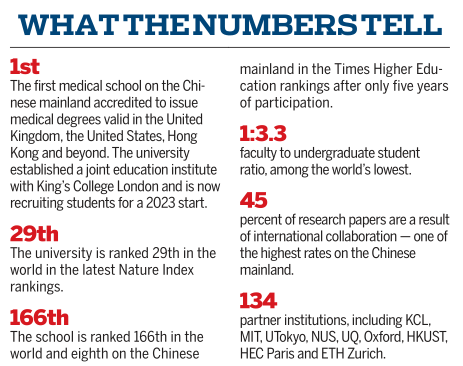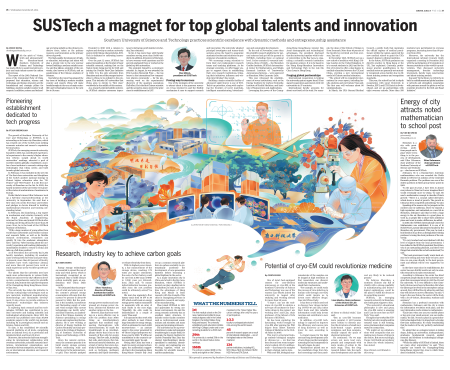
Zhao Tianshou, director of Energy Institute for Carbon Neutrality of SUSTech


WHAT THE NUMBERS TELL
Energy storage technologies are essential to spread the use of solar and wind power, which is increasingly recognized as an important step to fulfill China's carbon neutrality goals, an academician told China Daily recently.
"It's estimated that the proportion of wind and solar power in the country's primary energy consumption will surge from the current 4-5 percent to about 60 percent by 2060. But the problem is the unstable, inconsistent and fluctuating supply of solar and wind energies that current technologies can hardly solve," said Zhao Tianshou, an academician of the Chinese Academy of Sciences specializing in energy science and engineering thermophysics. He is now working as director of Energy Institute for Carbon Neutrality and chair professor at the College of Engineering of Southern University of Science and Technology, or SUSTech.
Given the natural environment, the common practice is to build energy storage systems before connecting solar and wind power to the national power grid. They include pumped storage power stations and compressed air storage power stations. Lithium-ion batteries are another option on the rise.
However, Zhao has been working on a more effective way to solve the problem since 2000.Using an interdisciplinary approach that combines engineering thermophysics with electrochemistry, he made the breakthrough in an interdisciplinary theory that is key to the research of flow cells for energy storage. The flow cells, including fuel cells, electrolyzers, flow batteries and metal-air batteries, are a kind of device that store electricity in flowable storage media, such as hydrogen, methanol, ammonia and liquid electrolyte, or release electricity from them.
With its highest power density, a key measurement of the storage device, reaching 2.75 watts per square centimeter, the costs of a flow battery could be cut from 3,400 yuan ($490) to 2,300 yuan per kilowatt-hour, Zhao said. "It means industrialization becomes possible since the cost problem could be ultimately solved," he noted.
His team has upgraded a flow battery stack from 10 kW to 30 kW, which could create an energy storage power station measurable in megawatts with an array of such stacks in the next stage. "Hopefully the cells could be industrialized in a couple of years," Zhao said.
It is expected to then work with other methods to meet China's huge demands for energy storage, which is estimated to reach 4,000 terawatt-hours — an amount equal to the power generated by 40 Three Gorges hydropower stations a year by 2060. "It will be our contribution to the country's carbon neutrality goals," he said.
Noting that China has been a leader in energy storage technologies, the academician suggested cities in the Guangdong-Hong Kong-Macao Greater Bay Area set up a common research platform in carbon neutrality to systematically accelerate the development of new-generation batteries before becoming a global highland in the sector.
As a major innovation city in China and a hub in the Bay Area, Shenzhen, where SUSTech is located, can play a leading role in the platform, he said. It can combine the advantages of Hong Kong and Macao in basic research with the strength of the cities in Guangdong province in application research and equipment manufacturing.
Zhao joined SUSTech in 2021 and appreciates its strong academic environment. He said the young research university has an excellent talent structure. It includes senior faculty members such as world-renowned academicians and scientists and many young and promising professors.
The university has set up several institutes to make technological breakthroughs in major fields, for example, the Energy Institute for Carbon Neutrality that Zhao has chaired. Interdisciplinary talents specialized in materials, chemistry, energy and engineering are working together, which are favorable for scientific research, said the academician.

